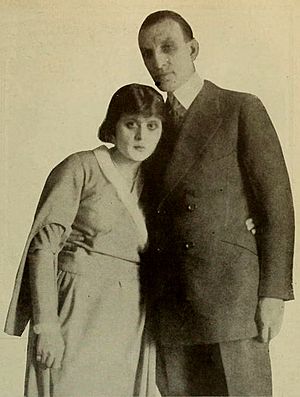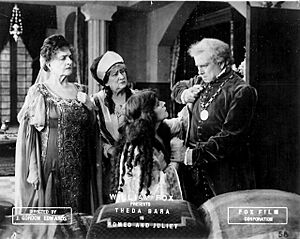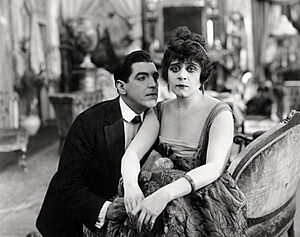Theda Bara facts for kids
Quick facts for kids
Theda Bara
|
|
|---|---|

Bara in 1921
|
|
| Born |
Theodosia Burr Goodman
July 29, 1885 Cincinnati, Ohio, U.S.
|
| Died | April 7, 1955 (aged 69) Los Angeles, California, U.S.
|
| Resting place | Forest Lawn Memorial Park Cemetery |
| Alma mater | University of Cincinnati |
| Occupation | Actress |
| Years active | 1908–1926 |
| Spouse(s) | |
Theda Bara (born Theodosia Burr Goodman; July 29, 1885 – April 7, 1955) was a famous American actress. She starred in many movies when films had no sound, known as silent films. She also acted on stage.
Theda Bara was one of the most popular actresses during the silent movie era. Movie studios created a made-up story about her. They said she was born in Egypt and was interested in magic. Theda Bara made over 40 films between 1914 and 1926. Sadly, most of these movies are now lost. They were destroyed in a big fire at a film storage building in 1937. After she married Charles Brabin in 1921, she made two more movies. She then stopped acting in 1926. She never appeared in a movie with sound.
Contents
Early Life and Beginnings
Theda Bara was born Theodosia Burr Goodman on July 29, 1885. She was born in Cincinnati, Ohio. Her father, Bernard Goodman, was a successful tailor from Poland. Her mother, Pauline Louise Françoise, was from Switzerland.
Theda had two younger siblings, Marque and Esther. Esther also became a film actress, known as Lori Bara. Theda went to Walnut Hills High School and graduated in 1903. She studied at the University of Cincinnati for two years. After that, she mostly worked in local theater plays. In 1908, she moved to New York City. She made her first appearance on Broadway that same year in a play called The Devil.
A Star's Journey
Most of Theda Bara's early movies were filmed on the East Coast. This was where the film industry was mainly located back then. She often filmed at Fox Studios in Fort Lee, New Jersey. Theda lived with her family in New York City during this time.
Later, Hollywood became the main center for American movies. This meant Theda had to move to Los Angeles. There, she filmed the big movie Cleopatra in 1917. This movie became one of her greatest successes. Sadly, no copies of Cleopatra exist today. But many pictures of Theda Bara dressed as the Queen of the Nile have survived.
Theda Bara was the biggest star for Fox studio between 1915 and 1919. However, she grew tired of always playing the same kind of character. This character was often called a "vamp." A vamp was a woman who used her charm to control men. Because she was tired of this role, she let her five-year contract with Fox end. Her last movie with Fox was The Lure of Ambition (1919).
In 1920, she briefly returned to the stage. She appeared on Broadway in a play called The Blue Flame. Theda Bara's fame brought many people to the theater. However, critics did not like her acting in the play.
Her movie career became harder without the support of Fox Studios. She did not make another film until The Unchastened Woman in 1925. She retired after making just one more film. This was a short comedy called Madame Mystery (1926). In this movie, Theda Bara made fun of her famous "vamp" image.
At the peak of her fame, Theda Bara earned a lot of money. She made $4,000 each week. This was like earning over $56,000 a week today! Her most famous roles were as the "vamp." But she tried to play other types of characters too. She played good heroines in movies like Under Two Flags and Her Double Life. She even played Juliet in a movie version of Shakespeare's Romeo and Juliet. Theda Bara took her acting very seriously. But she was so good at playing exotic women that it was hard for her to play other roles.
Her Stage Name and Image
People disagree about where Theda Bara's stage name came from. Some say it came from director Frank Powell. He knew Theda had a relative named Baranger, and Theda was her childhood nickname.
To promote her 1917 movie Cleopatra, Fox Studio publicists made up a story. They said her name was an anagram of "Arab death." Her agents also falsely said she was "the daughter of an Arab sheik and a French woman." They claimed she was born in the Sahara desert. This was to make her seem more mysterious and exotic to movie fans. In truth, Theda had never been to Egypt. Her time in France was only a few months. In 1917, her family legally changed their last name to Bara.
Her Public Persona
Theda Bara was known for wearing very revealing costumes in her films. These kinds of outfits were later banned from Hollywood movies. This happened after the Production Code (also called the Hays Code) started in 1930. It was strictly enforced from 1934.
It was popular at that time to promote actresses as mysterious. Studios often gave them exotic backgrounds. The studios promoted Theda Bara with a huge publicity campaign. They said she was born in Egypt. They claimed her mother was a French actress and her father an Italian sculptor. They also said she spent her early years in the Sahara desert. And that she lived under the shadow of the Sphinx. Then, they said she moved to France to become a stage actress.
Marriage and Later Life

Theda Bara married British-born American film director Charles Brabin in 1921. They went on their honeymoon in Nova Scotia, Canada. Later, they bought a large property there. They built a summer home they called Baranook. They did not have any children.
In 1936, she appeared on Lux Radio Theatre. She announced her plans to return to making movies. However, this never happened. She appeared on radio again in 1939 as a guest on Texaco Star Theatre. In 1949, there was talk of making a movie about Theda Bara's life. But this project also never happened.
Death
Theda Bara died on April 7, 1955, from stomach cancer. She was in California Lutheran Hospital in Los Angeles. She was buried as Theda Bara Brabin at Forest Lawn Memorial Park Cemetery in Glendale, California.
Legacy
Theda Bara received a star on the Hollywood Walk of Fame in 1960. This was for her important work in the film industry. Her star is located at 6307 Hollywood Boulevard.
Theda Bara never appeared in a movie with sound. A fire in 1937 at Fox's film storage vaults destroyed most of their silent films. Theda Bara made over 40 films. But only complete copies of six still exist: The Stain (1914), A Fool There Was (1915), East Lynne (1916), The Unchastened Woman (1925), and two short comedies.
Some small parts of her other films also exist. This includes a few seconds of Cleopatra. There are also clips from The Soul of Buddha and other unidentified films. These clips can be seen in the documentary The Woman with the Hungry Eyes (2006). Theda Bara once said, "I will continue doing vampires as long as people sin." In 2021, small pieces from her film Salome were found.
In 1994, Theda Bara was honored with her image on a U.S. postage stamp. In May 2006, a street in Fort Lee, New Jersey, was named "Theda Bara Way." This honored her because she made many of her films there.
A filmmaker named Phillip Dye recreated Cleopatra on video. He used still pictures from the movie and the few surviving film clips. He called his full-length movie Lost Cleopatra. He showed the film at the Hollywood Heritage Museum in 2017.
Filmography
| Year | Film | Role | Notes |
|---|---|---|---|
| 1914 | The Stain | Gang moll | Credited as Theodosia Goodman |
| 1915 | A Fool There Was | The Vampire | |
| 1915 | The Kreutzer Sonata | Celia Friedlander | Lost film |
| 1915 | The Clemenceau Case | Iza | Lost film |
| 1915 | The Devil's Daughter | Gioconda Dianti | Lost film |
| 1915 | Lady Audley's Secret | Helen Talboys | Lost film |
| 1915 | The Two Orphans | Henriette | Lost film |
| 1915 | Sin | Rosa | Lost film |
| 1915 | Carmen | Carmen | Lost film |
| 1915 | The Galley Slave | Francesca Brabaut | Lost film |
| 1915 | Destruction | Fernade | Lost film |
| 1916 | The Serpent | Vania Lazar | Lost film |
| 1916 | Gold and the Woman | Theresa Decordova | Lost film |
| 1916 | The Eternal Sapho | Laura Bruffins | Lost film |
| 1916 | East Lynne | Lady Isabel Carlisle | |
| 1916 | Under Two Flags | Cigarette | Lost film |
| 1916 | Her Double Life | Mary Doone | Lost film |
| 1916 | Romeo and Juliet | Juliet | Lost film |
| 1916 | The Vixen | Elsie Drummond | Lost film |
| 1917 | The Darling of Paris | Esmeralda | Lost film |
| 1917 | The Tiger Woman | Princess Petrovitch | Lost film |
| 1917 | Her Greatest Love | Hazel | Lost film |
| 1917 | Heart and Soul | Jess | Lost film |
| 1917 | Camille | Marguerite Gauthier | Lost film |
| 1917 | Cleopatra | Cleopatra | Approximately 20 seconds exist |
| 1917 | The Rose of Blood | Lisza Tapenka | Lost film |
| 1917 | Madame Du Barry | Jeanne Vaubernier | Lost film |
| 1918 | The Forbidden Path | Mary Lynde | Lost film |
| 1918 | The Soul of Buddha | Priestess | Story, Lost film |
| 1918 | Under the Yoke | Maria Valverda | Lost film |
| 1918 | Salomé | Salome | About 2 minutes survive |
| 1918 | When a Woman Sins | Lilian Marchard / Poppea | Lost film |
| 1918 | The She-Devil | Lorette | Lost film |
| 1919 | The Light | Blanchette Dumond, aka Madame Lefresne | Lost film |
| 1919 | When Men Desire | Marie Lohr | Lost film |
| 1919 | The Siren's Song | Marie Bernais | Lost film |
| 1919 | A Woman There Was | Princess Zara | Lost film |
| 1919 | Kathleen Mavourneen | Kathleen Cavanagh | Lost film |
| 1919 | La Belle Russe | Fleurett Sackton/La Belle Russe | Lost film |
| 1919 | The Lure of Ambition | Olga Dolan | Lost film; 82-second outtake does exist |
| 1925 | The Unchastened Woman | Caroline Knollys | |
| 1926 | Madame Mystery | Madame Mysterieux | Short film |
| 1926 | 45 Minutes from Hollywood | Herself | Short film |
See also
 In Spanish: Theda Bara para niños
In Spanish: Theda Bara para niños






